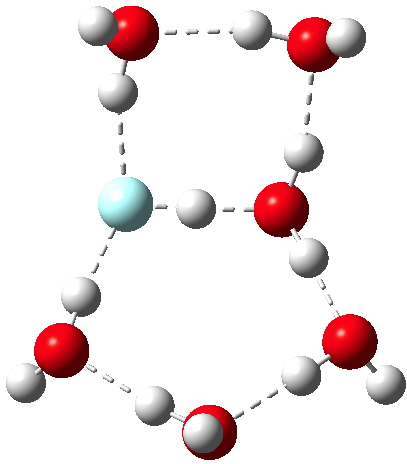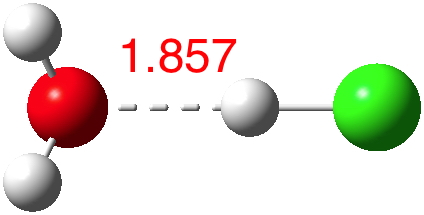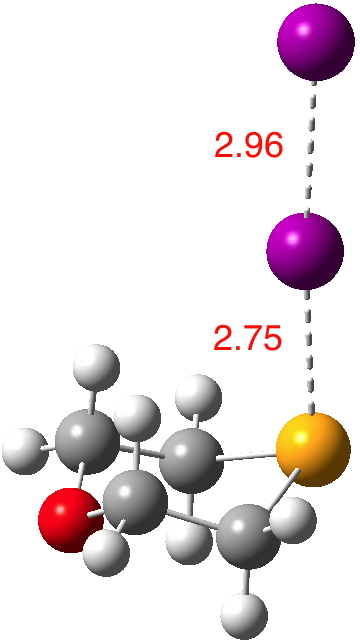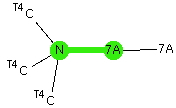Why is this post orphaned from the previous? In order to have the opportunity of noting that treating iodine computationally can be a little different from the procedures used for F, Cl and Br. As the nuclear charge increases proceeding down the periodic table, the inner electron shells start becoming relativistic.

No doubt answers to the question posed in the previous post are already being obtained by experiment. Just in case that does not emerge in the next day or so, I offer a prediction here. The methodology is the same as before, and I have not tried to look for new isomeric forms compared with the structures found with HCl.

According to Guggemos, Slavicek and Kresin, about 5-6![cite]10.1103/PhysRevLett.114.043401[/cite]. This is one of those simple ideas, which is probably quite tough to do experimentally. It involved blasting water vapour through a pinhole, adding HCl and measuring the dipole-moment induced deflection by an electric field.
Steganone is an unusual natural product, known for about 40 years now. The assignment of its absolute configurations makes for an interesting, on occasion rather confusing, and perhaps not entirely atypical story. I will start with the modern accepted stereochemical structure of this molecule, which comes in the form of two separately isolable atropisomers.
Sometimes you come across a bond in chemistry that just shouts at you. This happened to me in 1989[cite]10.1039/C39890001722[/cite] with the molecule shown below. Here is its story and, 26 years later, how I responded. To start at the beginning, there was a problem with the measured 1 H NMR spectrum; specifically (Y=H, Z=O) there are supposedly 16 protons, but only 15 could be located. What had happened to the 16th?

Continuing my hunt, here is a candidate for a strong(est?) halogen bond, this time between Se and I.[cite]10.1021/ic50038a006[/cite]. The features of interest include: The six-membered ring is in the chair conformation.

Nitrogen tri-iodide, or more accurately the complex between it and ammonia ranks amongst the oldest known molecules (1812). I became familiar with it around the age of 12-13, in an era long gone when boys (and very possibly girls too) were allowed to make such substances in their parent’s back gardens ‡ and in fact in the school science laboratory, † an experiment which earned me a personal request to visit the head teacher.

Pursuing the topic of halogen bonds, the system DABCO (a tertiary dibase) and iodine form an intriguing complex. Here I explore some unusual features of the structure HEKZOO[cite]10.5517/CCYJN03[/cite] as published in 2012[cite]10.1021/cg300669t[/cite] and ask whether the bonding between the donor (N) and the acceptor (I-I) really is best described as a “non-covalent-interaction” (NCI) or not.

Halogen bonds are less familiar cousins to hydrogen bonds. They are defined as non-covalent interactions (NCI) between a halogen atom ( X , acting as a Lewis acid, in accepting electrons) and a Lewis base D donating electrons; D….X-A vs D…H-A . They are superficially surprising, since both D and X look like electron rich species.
This second report highlights two “themes”, or common ideas that seem to emerge spontaneously from diversely different talks. Most conferences do have them. The first is “ embedding “, which in this context means treating different parts of a probably complex molecular system at different levels of theory.
